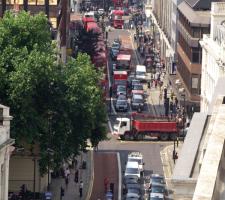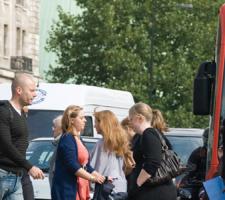
Urban traffic control is a well-defined and practised art. Nevertheless, there are technologies here and on the horizon with the potential to revolutionise how we do things. By Gavin Jackman and Andrew Kirkham, TRL, and Jason Barnes
Distributed monitoring and control of urban traffic networks and flows is nothing new. PC-based Urban Traffic Control (UTC) is now well established and operating in many locations around the world. However, it is worth considering the effects of the huge growth in the use of smart phones and their associated, travel-related applications on management strategies.At first sight, there are many potential positives to this. The sheer number of devices and dissemination channels makes it far easier to get information to those who need it. Meanwhile, if one considers the use of mass-market communications protocols (Bluetooth and others) there is a huge and (presently) barely tapped facility to gather and backhaul data on presence, speed and flow across all modes of transport.
The potential negatives are no less minor, however. The great advantage of 'traditional', centralised UTC (and this still includes later, more distributed PC-based iterations) is that data quality and timeliness can be accurate, especially important when transport networks are experiencing their greatest loads, but this will more than likely be scrutinised when disseminated to a wider user or consumer base.
Dissemination can be tied to desired outcomes in terms of road users' movements, which can be predicted and anticipated as a result. However, in the Brave New World of smart phones (and more particularly apps), there is the danger of all this breaking down - at least for a while. The hugely increased number of information sources and the niche, if not to say selfish, ambitions of many apps and their creators, risks compromising well-researched and understood management strategies. We face a situation where only the fittest apps survive while those which are unreliable or inaccurate don't. In the medium term, this market forces approach should result in apps which are superbly fit for purpose. Until then, however, we face a situation where credibility could be severely compromised.
Happily, we haven't reached that situation yet. National, regional and local authorities and jurisdictions are still in control of giving out information, and that includes to app developers and suppliers. While data down to the link level is being provided to developers for integration into apps, we're not yet seeing those apps giving directions in real time.
Developmentally, the merging of such apps with satnav systems is perhaps 90 per cent there. Display to user is the key remaining part but while we have the technology to allow information service delivery, we do not yet have the necessary intelligence to make sense of all the different data and profiles of network users. Account has to be taken of different people's thresholds of acceptance of congestion and authorities' management strategies. For instance, many roads authorities' advice during a major incident is for drivers to stay on the affected or official diversion route. This stops other roads in the surrounding area becoming swamped, while flows on the incident route can then be controlled. In terms of 'distributed' information providers, such as
Straight from leftfield
There are other developments which could further aid both transport managers and road users. We're not yet at the stage where we can provide information in-vehicle or to individuals to the extent that we can do away with traffic signals, but we can take elements of existing control devices and infrastructure to show where congestion is and then control traffic speeds and flows. The concept is analogous to the Managed Motorways system deployed on motorways in the UK but applied in an urban setting. The UK's Sentience research project from a couple of years ago demonstrated the potential here. Sentience was originally conceived to look at how prior knowledge of topography (for example, traffic signal locations, speed bumps, curves/intersections and inclines) could be used to govern vehicle drivetrain response and thus guarantee constant speed and better energy consumption. But it also served to illustrate how smoother rides equated to smoother flows. Moreover, if only a percentage of vehicles are equipped in such a manner there is still a positive influence on those in the vicinity.Merging the social into the technical
TRL is currently working with Newcastle University on a deployment in the Medway, Kent area of England which is looking to develop policies to manage environmental considerations such as noise and emissions while providing a non-bias to vehicles.
The deployment is using 'mote' wireless ad hoc sensors previously utilised in the Message project. Motes, which are now developed and sold by EnviroWatch, are suitable for dense deployments in urban areas; an individual mote is a low-power (solar with battery back-up) device which uses the ZigBee protocol to route between data nodes and to a central gateway for backhaul to a data management system. Typically a network of sensors is deployed with sensors attached to street furniture (lamp columns and railings) with up to 80m between nodes, allowing continuous, minute-by-minute monitoring of the pollution distribution over an area.
An example of the types of strategies to be explored is whether or not extended signal green phases can be used to reduce emissions build-up in areas where there are high numbers of pedestrians. More intelligence will be lent to this by fusing data from other sources. For instance, wind direction information from the UK's Met Office could be used to decide whether intervention into traffic flows is necessary; wind travelling in one direction might lead to a concentration of pollutants, while wind travelling in another might not be a problem.
Another interest is the social aspects of such interventions, and how to encourage drivers (most of whom tend to pursue fundamentally selfish agendas) to avoid certain areas or consider how else to reduce emissions.Studies of Intelligent Speed Adaptation (ISA) in the urban environment probably haven't gone nearly as far as they need to as yet. The application of ISA can be viewed as an extension of the green wave concept and conversations with network operators have confirmed that they would like these scenarios and strategies in their management toolsets.
More from the same
Efforts are underway to identify what more data can be had out of the existing systems - and what is lacking, and where. Local authorities in the UK, the Nordic countries, the Netherlands and the US have all been looking at Bluetooth as a means of detection. A spontaneous, internal survey of employees atThere are a couple of EU research calls out at present which relate to predictive modelling and the need for standards and protocols. This is a different topic but it actually sits very close to UTC: how to deploy microsimulation (such as online, near-real-time versions of
The use of consumer electronics has the benefit of reducing cost: it is much cheaper to adapt something off the shelf to traffic applications than to create something bespoke.
Cost is a major driver internationally right now and it is perhaps worth asking what data do we need, rather than presuming that we need what we currently have. Talk of new data types and sources is exciting but the reality is that in the Brave New World of Austerity, especially in the bigger projects, there is a drive to use existing systems somehow 'better'; whether that is in fact the creation of something new is a topic worthy of a discussion in itself. And if we are to use something which is already there, then that has to encompass mobile devices either as probes or as portals.
Ringing in the new
As is so often the case, some of the biggest barriers to making all this happen are psychological. It's very hard to take some people, in this case traffic managers with their engineering schooling and mindsets, away from proven sources and models to something new. It's possible that the use of mobile devices as probes, for example, won't give complete data for a given location but it will still give useable data. Engineers like certainties, and want to ensure that their decisions use accurate data for all possible inputs. There is another debate here over how accurate data needs to be to be usable and effective - after all, something is better than nothing - and the current mismatch between social and highly geared engineering mentalities is something that will have to be managed (see Sidebar, 'Merging the social into the technical').In many respects, some of the tried and tested elements of UTC are already bringing such elements as data fusion and re-use together. SCOOT for example has been around for 30 years now and for most of that time it has been used to prioritise motorised vehicles. Latest versions emphasise multimodality and add pedestrian priority and flow. Bicycle detection has also been looked at. Bus prioritisation, another long-established element of UTC, set the precedent for this but it demonstrates a clear current trend: the need to be able to give control to different modes of transport and manage congestion in order to give journey time reliability.
RSS












